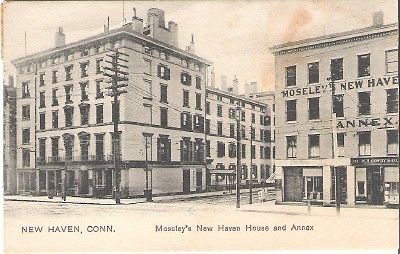1909. City of New Haven.
New Haven in the U.S. state of Connecticut, is the principal municipality in Greater New Haven. It is located on New Haven Harbor on the northern shore of Long Island Sound in New Haven County, Connecticut, and is part of the New York metropolitan area. It is the second-largest city in Connecticut (after Bridgeport).
New Haven was founded in 1638 by English Puritans, and a year later eight streets were laid out in a four-by-four grid, creating what is commonly known as the “Nine Square Plan”. The central common block is the New Haven Green, a 16-acre (6 ha) square, and the center of Downtown New Haven. The Green is now a National Historic Landmark and the “Nine Square Plan” is recognized by the American Planning Association as a National Planning Landmark.
New Haven is the home of Yale University. The university is an integral part of the city’s economy, being New Haven’s biggest taxpayer and employer. Health care (hospitals and biotechnology), professional services (legal, architectural, marketing, and engineering), financial services, and retail trade also help to form an economic base for the city.
The city served as co-capital of Connecticut from 1701 until 1873, when sole governance was transferred to the more centrally located city of Hartford. New Haven has since billed itself as the “Cultural Capital of Connecticut” for its supply of established theaters, museums, and music venues. New Haven had the first public tree planting program in America, producing a canopy of mature trees (including some large elms) that gave New Haven the nickname “The Elm City”.
New Haven has many architectural landmarks dating from every important time period and architectural style in American history. The city has been home to a number of architects and architectural firms that have left their mark on the city including Ithiel Town and Henry Austin in the 19th century and Cesar Pelli, Warren Platner, Kevin Roche, Herbert Newman and Barry Svigals in the 20th. The Yale School of Architecture has fostered this important component of the city’s economy. Cass Gilbert, of the Beaux-Arts school, designed New Haven’s Union Station and the New Haven Free Public Library and was also commissioned for a City Beautiful plan in 1919.
Frank Lloyd Wright, Marcel Breuer, Alexander Jackson Davis, Philip C. Johnson, Gordon Bunshaft, Louis Kahn, James Gamble Rogers, Frank Gehry, Charles Willard Moore, Stefan Behnisch, James Polshek, Paul Rudolph, Eero Saarinen and Robert Venturi all have designed buildings in New Haven. Yale’s 1950s-era Ingalls Rink, designed by Eero Saarinen, was included on the America’s Favorite Architecture list created in 2007.
New Haven is connected to New York City by commuter rail, regional rail and inter-city rail, provided by Metro-North Railroad (commuter rail), Shore Line East (commuter rail), and Amtrak (regional and intercity rail) respectively, allowing New Haven residents to commute to work in New York City (just under two hours by train).

